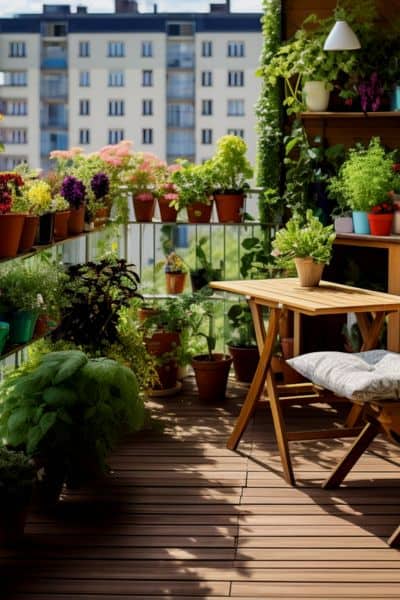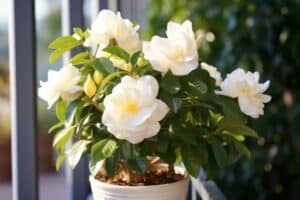Growing plants on your balcony can be very rewarding, but it can also lead to costly mistakes if you’re not careful.
To ensure that your balcony garden is a success, here are 10 common mistakes to avoid when you’re starting out.
This post contains affiliate links. Please read the disclosure for more info.

10 BALCONY GARDEN MISTAKES TO AVOID
1. Choosing the Wrong Plants for the Location
As a landscape gardener, I’ve seen my fair share of mistakes when it comes to balcony gardening.
One of the biggest mistakes I see is choosing plants that aren’t suited to the conditions on a balcony, such as plants that require full sun when the balcony only gets partial sun.
In this section, I’ll discuss three important factors to consider when choosing plants for your balcony garden: sunlight exposure, wind conditions, and taking the mature sizes into account.
Sunlight Exposure
Plants have varying needs for sunlight exposure, so take care to ensure that your plants will thrive in the amount of sun your balcony receives.
If your balcony gets full sun throughout the day, select sun-loving plants like lavender or geraniums.
On the other hand, if your balcony is mostly shady, opt for shade-tolerant plants like ferns, coleus or hostas.
Wind Conditions
Wind can be a significant factor when it comes to plant selection for your balcony garden.
Tall plants with large leaves can easily snap when exposed to strong winds, so it’s best to choose low-growing or sturdy-stemmed plants that are more wind tolerant if you have a windy balcony.
RELATED: 10 Best Wind Tolerant Flowers
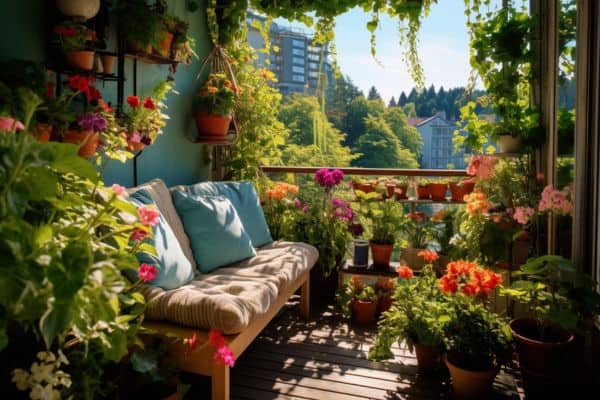
Not Taking Mature Sizes Into Account
When selecting plants for your balcony garden, always consider the mature size of the plant.
Small seedlings or young plants might be manageable at first, but they can quickly outgrow your limited balcony space.
To avoid overcrowding and stress on your plants, choose species that have manageable growth habits and mature sizes that work well with the space you have available.
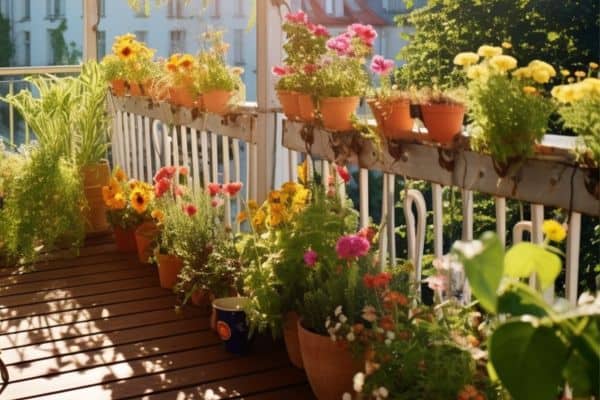
2. Not Considering the Climate
When you’re shopping for plants for your new balcony garden, it’s important to select plants that grow well in your climate.
If you live in a cool climate area, don’t choose plants that are frost sensitive, like geraniums, gardenias or plumerias.
If you live in a hot climate, avoid plants that don’t tolerate hot temperatures well, like lettuce, spinach and brassica family vegetables such as broccoli.
3. Choosing the Wrong Containers
Picking the right container is essential for the success and health of your plants.
When selecting containers, consider the material they’re made of.
Terracotta pots look nice but they’re heavy and dry out fast in hot weather, while plastic containers are lightweight and retain moisture better.
Also, it’s important to choose the right size containers for your plants.
A common mistake is using containers that are too small, which can cause root-bound plants, as well as poor growth and dry soil.
Make sure to select containers that give your plants enough room for their roots to develop.
Martha Stewart Living recommends repotting plants in the springtime and moving them into a container that is roughly two inches (2.5 cm) larger than their current container.
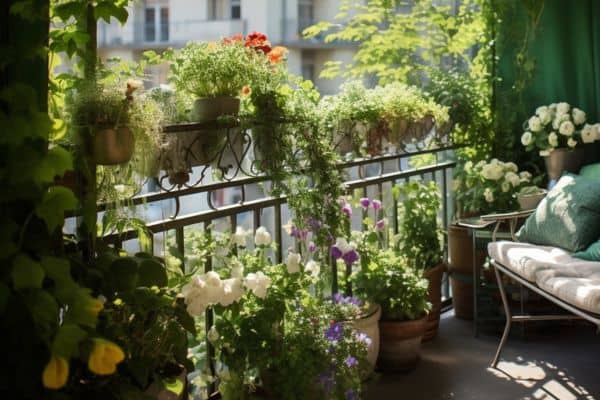
4. Using Poor Quality Soil
Choosing the right potting soil is crucial for your plants’ growth.
Avoid using soil that is too sandy, as it can drain water too quickly and lead to dehydration.
On the other hand, soil that is too heavy could retain too much water and cause root rot.
Look for a quality balanced potting mix that provides proper drainage and moisture retention.
It’s also a good idea to improve your soil with organic matter. Adding compost or aged manure to your balcony garden can work wonders to increase the quality of your soil.
Organic matter helps improve soil structure, provides essential nutrients, and encourages beneficial microorganisms to thrive.
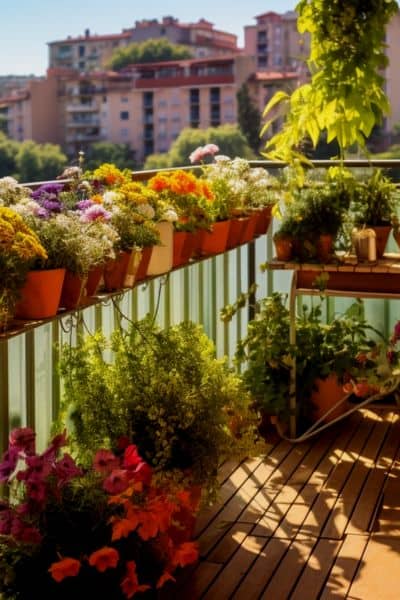
5. Neglecting Drainage
Another common mistake in balcony gardening is neglecting proper drainage.
Inadequate drainage can lead to plant stress and stunted growth.
Always ensure that your pots have drainage holes at the bottom.
This allows excess water to escape and prevents your plants from sitting in soggy soil.
You can easily find pots with pre-made drainage holes or create them yourself using a drill.
Another effective solution is placing saucers with a layer of pebbles underneath your pots.
The pebbles elevate the pot slightly, which helps with drainage and keeps the pot from sitting in standing water.
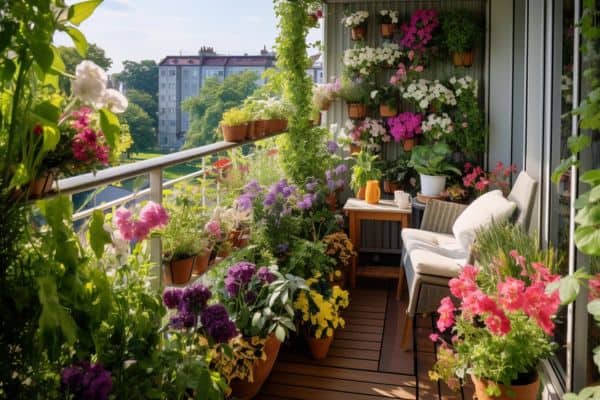
6. Over-Watering
When the soil is constantly wet, the roots don’t get a chance to breathe, and this may cause them to rot. To prevent this, always check the soil’s moisture before watering your plants.
Stick your finger approximately 1 to 2 inches (2.5 to 5 cm) into the soil to feel for moisture. If it’s still wet, hold off on watering until the soil has dried out a bit.
Lastly, over-watering can lead to nutrient leaching. When plants receive too much water, the excess moisture can wash away essential nutrients from the soil, impacting their growth.
Use mulch around your plants to help retain moisture and maintain consistent watering practices to prevent nutrient loss.
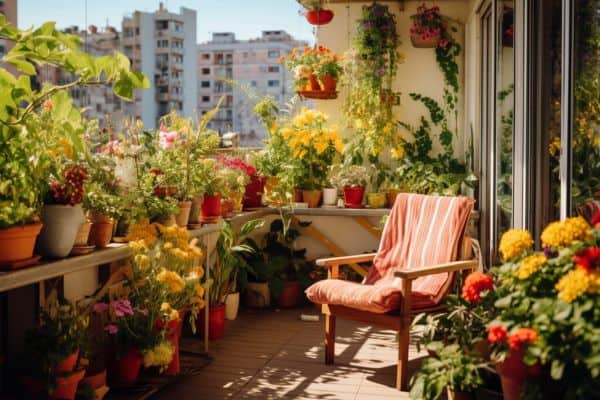
7. Overcrowding Plants
Overcrowded plants compete for light, water, and nutrients, which can result in weak and unhealthy growth.
To avoid overcrowding, it’s important to research the growing requirements of each plant species you want to include in your garden.
Consider their mature size and be sure to space them accordingly.
If you’re unsure of the correct spacing, look for guidance on the plant tags, do some online research or consult a gardening expert.
Overcrowding the balcony with plants can create a breeding ground for various diseases and pests.
A constantly damp environment is perfect for fungi and other pathogens to thrive, which can damage your plants and spread to other parts of your balcony garden.
To help deter pests and diseases, ensure proper air circulation around your plants and prune away any dead or unhealthy foliage.
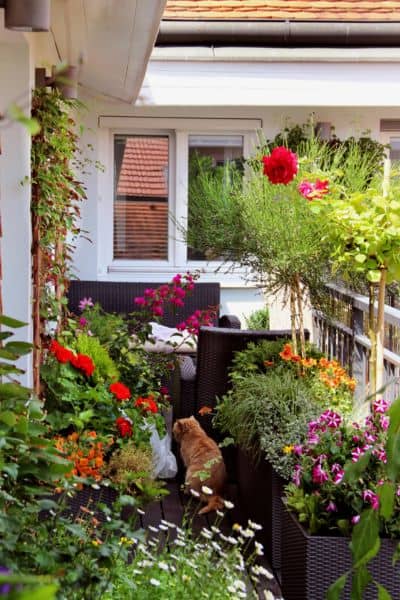
8. Over-Fertilization
Too much fertilizer can cause chlorosis (yellowing of leaves) and lesions on roots and stems.[1]
In some cases, leaves might fall off prematurely, and your plants’ root growth could be reduced.
To avoid over-fertilizing your plants, follow the recommended dosage and application instructions provided on the fertilizer packaging.
If you’ve accidentally over-fertilized your plants, you can flood the plants with water to help flush away the excess nutrients.
Another way to avoid over-fertilization is by using a slow-release fertilizer.
These fertilizers release nutrients over an extended period, reducing the risk of harming your plants.

9. Not Treating Pests & Diseases
For a successful balcony garden it’s essential to be on the lookout for common pests and diseases that can harm your plants.
Monitoring your plants regularly can help you spot signs of pests or diseases early on.
For common garden pests such as aphids, whiteflies, and spider mites, consider using natural methods like releasing beneficial insects, like ladybugs or lacewings, to keep their populations in check.
You can also spray the leaves with neem oil or insecticidal soap to get rid of annoying pests.
Another crucial step is keeping your garden tools clean. Sanitize your shears and other tools by wiping them with rubbing alcohol before and after each use.
Finally, be mindful of watering practices. Watering your plants in the morning and keeping the foliage dry can help prevent the spread of fungal diseases like powdery mildew.
Proper airflow around your plants is also vital, so make sure to provide enough space between them to avoid creating a humid environment where diseases can thrive.

10. Not Pruning Regularly
Pruning is a crucial maintenance task you should incorporate as part of your gardening routine.
Plants can quickly become overcrowded if they’re not trimmed regularly. A lack of space can hinder their ability to grow and plants in tight spaces are more likely to compete for essential resources like water, sunlight, and nutrients.
Pruning also encourages productive growth and helps plants bloom better.
By pruning your plants regularly, you’re removing dead or diseased branches, which allows your plants to focus their energy on producing more flowers, fruits, or foliage.
Lastly, neglecting pruning can increase your plants’ vulnerability to pests and diseases. Dead or damaged branches can attract pests and create an ideal environment for diseases.

RELATED ARTICLES
- 10 Best Trees for Balconies
- Advantages of Container Gardening
- Winter Balcony Garden Care
- 12 Full Sun Container Flowers
So there are some of the most common things to avoid when setting up a new balcony garden.
Balcony gardening poses unique challenges that come with managing plants in a small, elevated environment.
Factors such as limited space, exposure to wind, and quicker drying times for containers can all impact the health of your plants.
By being aware of these challenges and learning how to address them effectively, you’ll be better equipped to create a resilient, attractive garden that complements your urban lifestyle.
Are you on Pinterest? Check out my Balcony Garden and Flower Gardening boards. You can also find me on Facebook.


